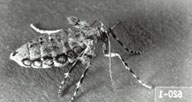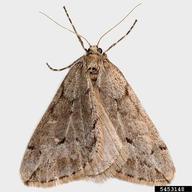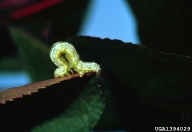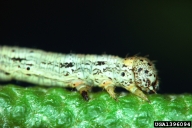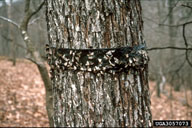Spring cankerworm
Paleacrita vernata (Peck) (Lepidoptera: Geometridae)
Orientation to pest
Spring cankerworm, Paleacrita vernata (Peck), is a native North American moth that defoliates many hardwood species and in some locations goes into periodic outbreaks. Damage is caused by young "inchworm" larvae skeletonizing new leaves and older larvae consuming all but the larger veins or midrib. This species may be confused with the very similar fall cankerworm, Alsophila pometaria (Harris). Adults emerge from pupal cells in the soil in early spring when the ground is thawed. Females crawl up tree trunks to lay eggs, which are deposited in loose clusters of 100 or more in bark crevices or under bark scales. Eggs hatch in early spring and larvae feed on leaves through the end of spring. Mature larvae drop to the soil on silk threads in summer. Larvae remain dormant within their soil-covered pupal cells throughout the rest of the summer and fall, pupating in late fall or early spring. There is one generation per year.
Hosts commonly attacked
In North America, larvae of this moth feed on many hardwood species, including elm (Ulmus), green ash (Fraxinus pennsylvanica Marsh.), maple (Acer), bur oak (Quercus macrocarpa Michx.), linden/basswood (Tilia), silver birch (Betula pendula Roth), and apple (Malus domestica Borkh.).
Distribution
This geometrid is found in southeastern Canada, as well as throughout the northeastern and north central United States, and west to parts of Texas, Colorado and California.
Images of spring cankerworm
| Figure 1. Adults of spring cankerworm, Paleacrita vernata; top: wingless female, bottom: male |
Figure 2. Larvae of spring cankerworm | Figure 3. Tree trunk with band trap to catch female spring cankerworms as they crawl up trees |
Important biological control agents related to this pest species
Several species of parasitoids are known from spring cankerworm, including three braconids, Rogas geometrae Ashmead, Apanteles paleacritae Riley, and Meteorus hyphantriae Riley. It is also attacked by the ichneumonids Phobcampe geometrae (Ashmead) and Hyposoter fuscitarsis (Vierieck). Bacillus thuringiensis Berliner is bacterium that has been formulated as a biopesticide that can be used to control larvae of this species.
Web links for information on spring cankerworm
- Fact Sheet | Ohio State University Extension
Compares spring and fall cankerworms - Fact Sheet | University of Minnesota Extension
Compares spring and fall cankerworms - A Field Guide to Common Texas Insects | AgriLife Extension, Texas A&M System
- Woody Ornamentals Identification and Damage Guide | University of Nebraska-Lincoln
Articles
- Frye, R. D., D. K. McBride, D. R. Carey, T. L. Elichuk, and R. L. Dregseth. 1977. Cankerworm control in shelterbelts. North Dakota Farm Research 34(6): 3-7.
- France, K. R. la and A. R. Westwood. 2006. An assessment of tree banding techniques to capture cankerworm defoliators of elm and ash trees in Winnipeg, Manitoba, Canada. Arboriculture and Urban Forestry 32: 10-17.
